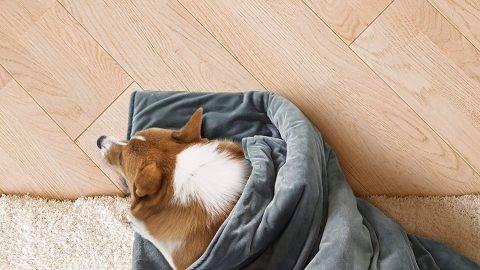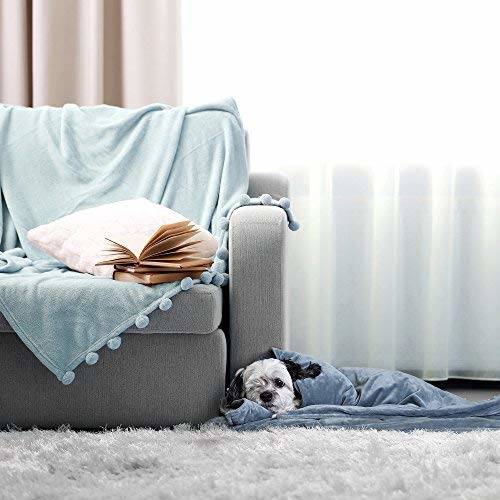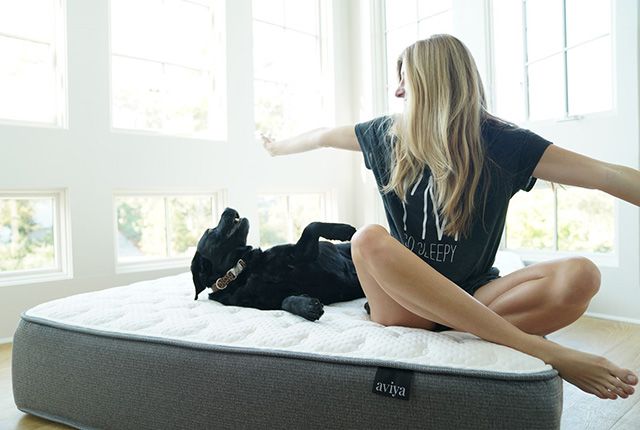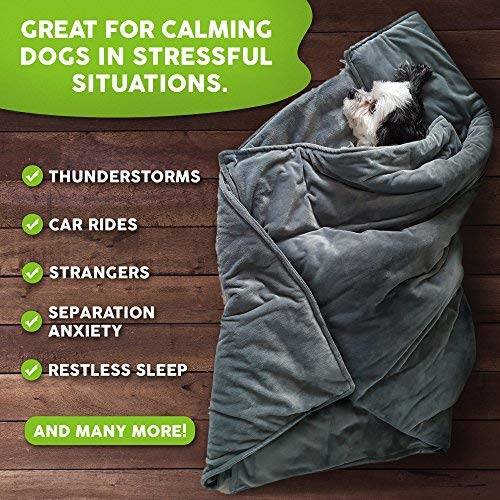Weighted blankets are quite a sensation amongst adults who have several sleep-related issues. They are commonly known for the deep pressure stimulation, which lies at the base of every weighted blanket. Even studies suggest that using such a product can help with stress and anxiety, different muscle and joint pains, ADHD, autism, PTSD, insomnia, and other problems that could literally keep someone up at night.

Weighted Blankets for Dogs with Anxiety
Believe it or not, anxiety in animals is a thing. Should you decide to ignore it, this leads to long-term behavioral problems, so look after the following signs:
- Dogs that are anxious will bark often and for no reason. It’s perfectly fine if you hear your doggo barking when they see something unusual in or outside the house, or if they’re feeling hungry or want to go for a walk, but if your dog bags for no reasons and there’s no calming them down, this might be a sign of anxiety.
- Even if people normally associate dogs wagging their tails with happiness, this could actually be a manifestation of anxiety. Note that there is a difference between happy tail wiggling and thumbing, which is slower and more aggressive.
- Another sign of canine anxiety is involuntary peeing while walking around. Much like humans, dogs also have the fight-or-flight response, which relaxes their body as a response of their sympathetic nervous system response. If you become verbally aggressive with your dog in such a scenario, you’re only increasing their anxiety and giving them something else to fear.
- When they’re feeling anxious, dogs also have a tendency to escape. When this occurs, make sure that you never leave your doors or gates open, and always try to have a second barrier protecting the doorway.
- It’s not uncommon for anxious dogs to hide around the house a lot. That’s because anxiety makes us want to part from things that we fear. Dogs tend to hide in secluded corners, but sometimes even behind the owner’s legs, if that’s a place where they feel safe.
- Dogs that often yawn may feel stressed. This is usually accompanied by lip licking.
- Anxious dogs have the tendency of chewing everything in sight. This is how the dog releases all the negative energy that is a product of anxiety. You could try to purchase chew toys for your dog, to make sure they avoid destroying stuff around the house.
- Much like humans, dogs also tremble and shake when feeling anxious. You might even notice that they have a worried frown, with wide eyes and expressive ears.
What Are Anxiety Blankets?

The weighted blanket functions on the principle of deep pressure stimulation, and is looking to replicate the sensation that you get when you’re feeling hugged. It’s not just jibber jabber, it’s actually a psychological proven fact that hugs activate our happy hormones and provide us with a sense of calm and protection.
Through sensory integration, a weighted blanket can apply consistent pressure on the human body, basically “pushing the right buttons” to relieve people of stress. This has an impact on both a physical and a psychological level.
Several studies have been conducted to witness if the benefits of weighted blanket can be scientifically proved. For instance, one particular study revealed that weighted blankets did not decrease the time it took for autistic children to fall asleep, but it did increase the quality of their sleep.
Are Weighted Blankets Good for Dogs?

What about weighted blankets for smaller dogs? One of these adult-oriented products can weight between 10 and 20 pounds, which makes it restrictive, especially for smaller dogs. They might not be able to move at all underneath all that weight, so it’s important to look for a product created for the size and weight of your companion.
It’s important to note that pets that have breathing-related problems (such as asthma), will have a harder time breathing underneath such a blanket. Other categories of dogs that should not use this product are those who have a skin condition, because the pressure applied by the blanket might lead to severe irritation.
A weighted blanket might not be the best option for chewers. These blankets have a very small filling, something like plastic pellets or micro glass beads, which can easily be ingested if the dog chews through the cover of the blanket.
Should your dog swallow these, they will likely end up having an upset stomach and start vomiting or having diarrhea. In more drastic cases, these beads can end up causing intestinal blockage, which might require surgical intervention to remove the obstruction.
The Benefits of Weighted Blankets for Pets
As a lot of veterinarians and people working in animal shelters will tell you, there are secrets to choosing the very best weighted blanket for dogs. Truth of the matter is, there is no precise scientific evidence to suggest that weighted blankets really have therapeutic benefits for dogs.
The conclusions related to their efficiency is mainly based on two things: the scientific evidence that proves they are beneficial to humans, and the testimonials of dog owners who have tested these products on their anxiety-suffering dogs and states there was indeed a positive change in the canine’s behavior.

The actual human studies have shown that weighted blankets can help calm down nerves by mimicking a swaddling effect, according to LiveScience. As we’ve mentioned before, the phenomenon is called sensory integration, and it means that once pressure is applied on the body, it can decrease a person’s level of stress.
But even if weighted blankets do have proven benefits for humans, there are people who simply can’t adjust to sleeping properly with that much weight on them. The same principle is applied to dogs as well: while good, a weighted blanket isn’t something that all dogs can learn to sleep with.
According to behaviorists, trainers, and vets, a weighted blanket for your dog can prove useful in a variety of different situations:
- Dogs often feel anxious when they hear extremely loud noises (if you live in the US and own a dog, then you know the torment of firecrackers on July the 4th). Dogs have a much more developed sense of hearing, which makes them super-sensitive to sounds. A weighted blanket can help calm down some of that anxiety, particularly if you’re by your dog’s side to comfort them.
- If you’re going on vacation and have to leave your dog in some else’s care, they might feel stressed about being left behind (we all know that dogs are very attached to their owners and feel very sad when they miss them). A weighted blanket might help them sleep better, because there are high chances of them feeling restless inside a new home, and with new people around.
- Travelling with your dog can also cause anxiety, particularly if they’re not used to being inside a vehicle for too long. With a weighted blanket, you can rest assured that they will feel much more comfortable in sleeping, thus preventing them from barking or moving around in the car too much, causing discomfort to whoever else is travelling with you.
- A weighted blanket, with very few exceptions, is safe to use. As mentioned before, there are certain dogs that have respiratory problems or skin issues that might make weighted blankets uncomfortable, or even impossible to breathe under. Other than that, anxiety therapy with a weighted blanket should have no side effects. Even if your dog is on medication, weighted blankets are also worth trying, because you can always discontinue its use if it’s not working properly. A weighted blanket will never make your dog feel nauseous or constipated, nor will it decrease its appetite, so it’s a natural approach worth taking into consideration.
- Weighted blankets are an inexpensive therapeutic method. If your dog is receiving medical treatment for anxiety, it can be pretty expensive. If you leave your dog’s anxiety untreated, it can have several other negative consequences, including damage furniture, in case your dog starts chewing on everything. Even if a weighted blanket is more expensive compared to a regular blanket, it is still less expensive compared to other types of treatments and therapies you might consider trying.
- It’s true that anxiety in dogs can be treated with behavior and training modification, but these things take time and require quite the investment on behalf of the owner. A weighted blanket is a simple solution, and one that won’t cost nearly as much. You could give it a try, and then turn to other more complicated method in case this one doesn’t work for your dog.
Examining the Options

This particular weighted blanket for dogs is available in two size and weight options: one suitable for dogs that weight under 50 pounds, and another one for dogs above 50 pounds. It features a removable cover, which makes it easier for you to wash the outer shell of the blanket and then put the fill back in.

Even more important, a portion of the sales of this canine blanket are donated to support dogs in shelters, but also to underprivileged families that have expensive bills to pay for their sick pets.
Since the large version of this weighted blanket is seven pounds, which is just about the same weight as a blanket for children, you can look for alternative to the Canine Coddler, such as the Huggaroo.
While it might be designed for children, it does meet the specifications required for a large dog. Generally speaking, a weighted blanket should have about 10 percent of the wearer’s weight, with one or two extra pounds. That means that the blanket is good for large dogs that weigh about 60 to 80 pounds.
The fluffy exterior will be a delight to your pet, because it feels extremely cozy and nice when rubbed against the skin. The inner part of the blanket is made from cotton, and features micro glass beads, which are evenly distributed across the blanket’s surface.
Alternatives to Weighted Blankets
According to The Humane Society, there are three steps that a dog owner can take in order to help reduce their pet’s anxiety.

Dogs should have such a corner for themselves, whether it’s a corner for resting or calming down during an anxiety episode. Dogs need to feel secure, and the best way to do that (aside from never abandoning them), is to create such a spot.

Keep in mind: your dog may or may not have a “safe space”. That doesn’t mean that you should force them to sit in a particular spot during a storm. It means carefully observing if this place already exists and make it as comfortable for them as possible.
Another step towards helping your dog lead a more anxiety-free life is keeping them distracted when said anxiety kicks in. If you notice any of the behaviors that we mentioned at the beginning of this article, try to engage with your dog (assuming that helps them relax, not become highly agitated).

And, when everything else fails, you can always try behavioral therapy. This method is based on desensitization, which is basically a fancy word for exposing your dog to their fear until they’re less anxious about that trigger.
You may have heard about people being afraid of snakes or spiders, who have gradually been exposed to them until their fear was gone. The key approach is through baby steps: first a picture of a spider, then a video, then being in the same room with a live one and so forth, until one is comfortable with touching the critter.
With dogs, the same baby steps should be considered. This is very important, because forcing an animal to face their fear can trigger that primal instinct, and you may end up facing a very aggressive dog.
The best way to apply this method is to create positive experiences around that fear. Let’s take the thunderstorm example, for instance. If your dog is afraid of the sound of thunder, distract their attention while doing something they like.
Since you can’t always rely on Mother Nature to be of help, play a recording of a loud thunderstorm. In the meantime, give your dog their favorite treats, or give them a bath, if they like baths. If you notice that the dog is feeling more comfortable while still being exposed to that fear trigger, remember to praise them.
Through exercises like these, you can end up training your dog to associate thunderstorms with positive experiences.
Bottom Line
Even if there aren’t exact scientific studies conducted to see what the specific benefits of dogs are sleeping with a weighted blanket, there is evidence that clearly points the benefits that such a product can have on humans. Extrapolating the results, weighted blankets do seem like something to try, particularly since anxiety in dogs does have the same psychological impact as it does on humans.
Furthermore, a weighted blanket is quite an inexpensive therapeutic method, particularly when you compare it to the average costs of medical bills or behavioral training meant to keep the effects of anxiety under control.
While the market of weighted blankets for dogs is something that definitely leaves space for more products, you can always consider the option of buying a weighted blanket for children. The most important thing is to always remember the base rule: a weighted blanket should never weigh more than ten percent of your dog’s weight, plus a couple of extra pounds.

